Greco-Persian gems
Introduction
During the period of the Persian Empire, from the later sixth to the later fourth century BC, a series of gems were engraved in the western areas of the empire, mainly Anatolia (Turkey), which combine Greek style and subjects with Persian style and subjects. The main difference between these and the Classical Greek series is that the engraver tends not to disguise his technique, so that much of the patterning of figures is left in plain drill work. This follows eastern practice. Styles range from a very Persian 'Court Style' to subjects and poses which are wholly Greek except in details of their execution. The Persian subjects go far beyond the usual eastern range, which is very hieratic, and include rare views of Persian private life. The customers are Persians or Persian subjects, and in fighting scenes the Greeks are sometimes shown defeated. Animals are popular subjects, but shown in the eastern scheme of the 'flying gallop' and not the more realistic Greek. After the fall of the Persian empire there is an afterlife for the series, with Macedonian dress for some figures, and a prolific class of simple a globolo gems which are widely diffused in the east and come even to determine the style of Sasanian gems.
Shapes. The earliest are stamp seals of eastern type; then scaraboids like the Greek, especially favouring those with high, domed backs. There are also some tabloids, a few pear-shaped like pendants, and some multi-faceted bearing several different subjects. Cylinders, the prime eastern shape in the past, are rare.
Materials. Quartzes are preferred, especially chalcedony with a preference for the blue, which had been popular in Babylonia. There are fewer of opaque stones. Generally the range is as that for the Classical Greek.
Bibliography. J. Boardman, Greek Gems and Finger Rings (1970/2001) Chapter VI (= GGFR); Persia and the West (2000) 166-174.
Pyramidal stamp seals
The shape is Babylonian and the preferred material is blue chalcedony. They were made from the later sixth century into the fifth, mainly in western Anatolia. Several are inscribed with Lydian, some with Phrygian names, presumably for local officials in the Persian administrative capitals (notably at Sardis). Some are mounted in silver in a Lydian manner, as pendants. Most bear Persian subjects done in a style quite close to Greek late archaic, and there are a few with purely Greek subjects. Many are distinguished by having linear devices on them which are the personal blazons of individuals - a practice which was adopted from that of masons in Lydia and later in the east generally. See J. Boardman, Iran 8 (1970) 19-45, and 36 (1998) 1-13.

Geneva 20564, from Cyprus. Blue chalcedony. 18mm. Iran 8, no. 6.
A bull, in a style close to Greek late archaic. Inscribed in Lydian 'of Manes'; and with a personal device before the animal.

Philadelphia CBS.5117. 17.5mm. Iran 8, no. 8.
An eastern monster composed of a horned winged lion, a goat-sphinx and a boar. With a Lydian inscription and a personal device.

NewYork 86.1.3. Chalcedony. 17mm. Iran 8, no. 11.
A Greek Hermes with winged cap and shoes, holding a caduceus and flower, with a bird before him.
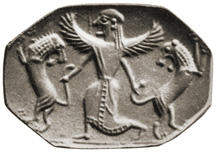
Bowdoin College 484, from the Black Sea area. Chalcedony. 20mm. GGFR pl. 823.
A Greek mistress of animals holding lions; a very Lydian subject.

St Petersburg, from Crimea. Cornelian. 19mm. Iran 8, no.5.
There is the occasional scaraboid in this series. Two Persian royal sphinxes; inscribed in Lydian 'of Manes' (a common Lydian name), with a personal device.
Court style
These are the most Persian in style, technique and subjects, but the scaraboid shapes are not those used by engravers in Persia itself. There is much very fine drill work and detailing of animal bodies, as on the stone reliefs in Persia.

Oxford 1965.362. Red and yellow jasper scaraboid. 20mm. GGFR pl. 837.
A Persian royal winged bull.

Oxford 1885.491, from Nymphaeum, Crimea. Blue chalcedony scaraboid. GGFR pl. 838.
A horned, winged lion monster, with eagle hindlegs and ostrich tail.
Greek subjects
These are surprisingly seldom much like those chosen for the Classical Greek series and include some important iconography not matched in other Greek gem engraving rather than in major arts.

Hermes and Athens. Apparently statuary types.
Istanbul, from Sardis. Blue chalcedony scaraboid. 29mm. GGFR pl. 855.

Herakles stands over the dead Nemean lion, his club behind him. A nymph (Nemea?) moves towards him with a water jar; Eros overhead with a wreath suggests an erotic interest. The hero with the dead lion is known otherwise only in gem impressions of this sty10 April, 2012, Walters, no. 524, from the Punjab. Blue chalcedony scaraboid. 35mm. GGFR pl. 856.

A. A Persian bowman.

B. A Greek with his dog.

C. A naked woman stretches.

D. A cock fight.
Leningrad, from Anapa. 20mm. GGFR pl. 861.
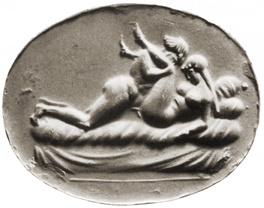
Love-making. The woman's pigtail shows that she is a Persian, who would never be shown naked in Persian art.
Boston, from Tripolitza. Chalcedony scaraboid. 24mm. GGFR pl. 862.
Domestic
The scenes of Persian men with their women, the women with their children and dogs, or of Persians relaxing, even dancing, are very much in the spirit of Greek Classical art and not at all of eastern art where such low-key personal subjects are quite exceptional. Yet, except for the seated women, they are not subjects exactly matched in the Greek repertoire on gems, where husband-and-wife groups are virtually unknown. The women wear fuller dress than the Greek, are more buxom and have pigtails; the men wear soft flat caps, jackets and trousers.

A woman holding an alabastron (perfume vase) and a saucer and small ladle with which she will dispense it.
Berlin F 181, from Megalopolis. Chalcedony scaraboid. 27mm. GGFR pl. 854.

A woman, dressed and equipped as the last, approaches her man, seated on a stool. The inscription, a quotation from the Koran, was added later, showing that the stone was being worn also in Islamic times.
Oxford 1921.2. Blue chalcedony scaraboid. 24mm. GGFR pl. 880.

A. Man and wife. B. A woman holding a flower and a bird with her child.
London, Walters, no. 436, from Cyprus. Pear-shaped pendant of pink chalcedony. GGFR pl. 891.

A Persian man dancing.
Malibu, J. Paul Getty Museum 81.AN.76.88. Grey chalcedony scaraboid. 25mm. J. Boardman, Intaglios and Rings (1975) no. 88.

A 'rhyton' pouring vase of a common type in the Achaemenid empire and a prestige vessel. The forepart is an antelope.
Pais, Louvre AO 6916. Blue chalcedony scaraboid. 26mm. GGFR pl. 894.
Persian subjects - warfare
The opponents are various races within the Persian empire, including Greeks, who are generally shown naked, and most of the fighting schemes are those developed in Greek art.

A Persian king defeats a Greek hoplite, whose helmeted head is shown frontally.
Once Arndt Collection 1410, from Caria. Onyx scaraboid. 16mm. GGFR pl. 849.

A Persian horseman rides down a Greek hoplite.
Rome, Villa Giulia, from Bolsena. Chalcedony scaraboid. 28mm. GGFR pl. 881.
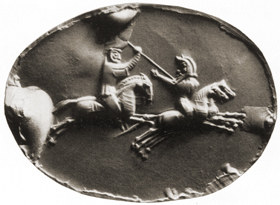
A Persian horseman attacks two Scythian (pointed caps) riders.
St Petersburg 375, from Asia Minor. Blue chalcedony scaraboid. 30mm. GGFR pl. 882.

Three Persian soldiers.
Paris, Bibl.Nat. N 3621. Blue chalcedony scaraboid. 21mm. GGFR pl. 877.

A Persian horseman attacks two Scythians in a chariot.
London, Walters, no. 435, from Mesopotamia. Cornelian scaraboid, cut on the convex back. 24mm. GGFR pl. 864.
Persian subjects - the hunt
The range of quarries is that to be expected in Anatolia rather than Greece, including lions, foxes, goats, bears, antelopes and stags. They are hunted on foot, horseback and from chariots, in the time-honoured manner of Mesopotamian art. Throughout the empire there were hunting gardens (paradeisoi) stocked with animals for the hunt.

A Persian bowman has caught a bird.
Oxford 1892.1482, from the Peloponnese. Chalcedony scaraboid. 26mm. GGFR pl. 853.

A Persian horseman chases a stag and a fox.
London, WA 120332. Pink chalcedony scaraboid. 20mm. GGFR pl. 888.

A Persian horseman and a Persian with a dead fox which has been hunted with a trident spear.
Berlin F 183, from Ithome. Chalcedony scaraboid. 25mm. GGFR pl. 890.

Persian horsemen confront a lion and a boar.
Cambridge. Chalcedony scaraboid. 29mm. GGFR pl. 924.
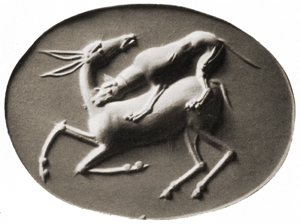
A dog attacks a deer.
Berlin F 307, from Athens. Blue chalcedony scaraboid. 25mm. GGFR pl. 895.
Animals

Birds pick the body of a dead stag.
[The mount is modern]
Malibu 81.AN.76.90. Blue chalcedony scaraboid. 31mm. J. Boardman, Intaglios and Rings (1975) no. 90.

A lion attacks a stag.
Malibu 81.AN.76.97. Blue chalcedony scaraboid. 33mm.J. Boardman, Intaglios and Rings (1975) no. 97.

A hyena.
Malibu 81.AN.76.92. Blue chalcedony scaraboid. 25mm. GGFR pl. 1069.

A Bactrian camel.
London, Walters, no. 547. Chalcedony scaraboid. 10 April, 2012

A fox; an antelope; a heron; a lizard.
Oxford 1925.134. Blue chalcedony prism. 21mm. GGFR pl. 934.

An ibex; a dog; a fox; a locust on an ear of corn.
New York, Rosen Collection. Mottled jasper poly-faceted pendant. 31mm. GGFR pl. 1068.
The Bern Group
The subjects here are as those in the earlier series but the personnel are now characterized as Macedonian, with their flat caps (kausia) and so these must date to just after the fall of the Persian empire, late fourth century or later. The style is more mannered and many details are rendered in a linear technique.

Two horsemen attack stags. The horses have horn-like forelocks.
Bern, Merz Collection. Blue chalcedony scaraboid. 40mm. GGFR pl. 965.

A two-horse chariot, the principal figure, a Macedonian, is protected by a parasol, an eastern indication of regality.
Harvard, Mitten Collection. Chalcedony scaraboid. 23mm. Revue Archéologique 1976, 52, fig. 13.

A seated Persian woman with a flower.
Cambridge. Pale red all-stone ring. 22mm. GGFR pl. 966.

A horseman attacks a rearing lion.
New York, Rosen Collection. Grey-brown chalcedony scaraboid. 28mm. GGFR pl. 1070.
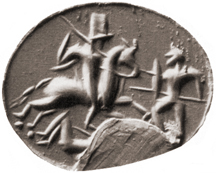
A horseman attacks a soldier with another dead beneath. The most summary of this style, verging on the a globolo.
Oxford 1892.1596, from Ephesus. Veined jasper scaraboid. 27mm. GGFR pl. 974.
A globolo gems
The style seems a continuation of the main Greco-Persian series into the Hellenistic, Seleucid period in Persia and probably later, with long influence in the east. The style is looser and lacks detail, depending much on simple drill work, but in many respects it resembles engraving style long current in various parts of the near east. The Greek element has virtually disappeared and several subjects are decidedly eastern (elephants, zebu).
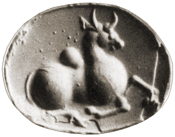
A zebu bull. Bonn, Müller Collectio.
Pale red chalcedony scaraboid. 14mm. GGFR pl. 985.

A winged lion.
St Petersburg 6441. Chalcedony scaraboid. 15mm. GGFR pl. 983.
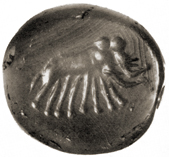
Two elephants.
Malibu 81.AN.76.104. Rosy agate scaraboid. 17mm. J. Boardman, Intaglios and Rings (1975) no. 104.





